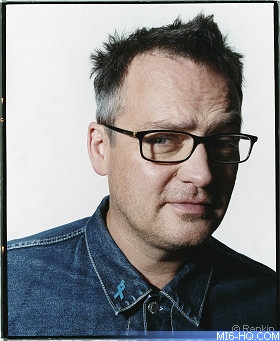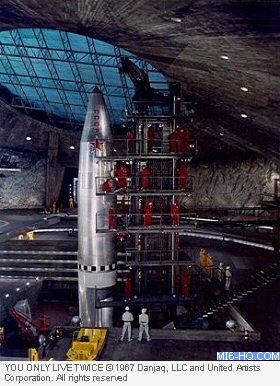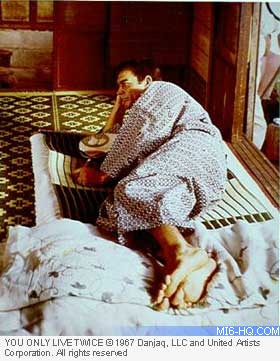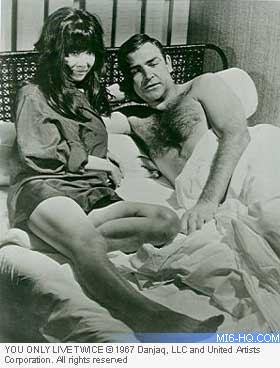Opinion - And Twice Is The Only Way To Live!
(3)
18th June 2007
In the third part of the special "And Twice Is
The Only Way To Live" series, authors reflect on "the big one"...
Charlie Higson - On The Start Of An Obsession...
I
often get asked which is my favourite Bond film and I always
go for You Only
Live Twice. I don’t know if it's the best Bond
film, but that’s not the point. It’s the one
that had the biggest effect on me when I was a kid. I remember
vividly when it came out, I was ten years old. It was the
most exciting thing in my life. I collected the trading cards
(all since lost, worst luck), I watched the behind the
scenes footage on TV and when I got to see the film I was
enthralled.
It had sumo wrestlers, piranhas, poison
dripping down a thread, it had Little
Nellie,
the one-man helicopter, it had Bond pretending to be Japanese,
it had one of John Barry’s most evocative scores,
but best of all was the volcano, and Blofeld and
his cat. The volcano set is still the quintessential Bond
set and Donald Pleasance is still the quintessential Bond
villain. The huge climax with armies of men in colour-coded
jumpsuits being machine-gunned and blown up was the icing
on the cake. Perfect entertainment for a ten-year-old boy. |
|

-- Charlie Higson, 2007 |
Charlie Higson is a writer,
actor and comedian. He is author of the Young
Bond series of novels. The fourth adventure, Hurricane
Gold, is due out in September 2007.
Gareth Owen - On The Incredible Set...
For You Only Live Twice
, Commander Bond traveled to Japan for one of his most ambitious
adventures. However, it became apparent early on in pre-production
that it would be impossible to find any of the locations Fleming
had described. 'I spent three weeks with
Cubby, Harry,
Lewis Gilbert [the director]
and Freddie Young [director of photography] in two helicopters,
and we covered two thirds of Japan,' production designer Ken Adam
remembers. 'We didn't find anything that Fleming had mentioned.
Fortunately, almost towards the end of our scout, we found this
volcano area in Kyushu, Southern Japan. And that triggered off
the whole thing about putting the villain into an extinct volcano.'
The volcano was then recreated at Pinewood
at a cost which exceeded the entire budget of Dr.
No. 'Cubby was amazing,' Adam continues. 'When he saw my
design he asked how much it was going to cost. I had no idea,
and just
said "About $1 million." He didn't blink an eye! He
said if I could do it for $1 million, I should go ahead.'
Once again, Adam was able to call upon the
talents of the Pinewood workforce for an undertaking far more
elaborate than anything he had previously designed. 'There were
several hundred tons of steel and the tubular alone would stretch
from London to Edinburgh. I had
a great team with me - Chip Brown, the builders at Pinewood,
the structural engineer and so on.
|

|
|
Had it been the Empire State building,
they would
have known how to cope quite easily. But because this was
an unusual structure - an artificial lake, 100 ft up, on
a slope, 70 ft in diameter - it was a different kettle
of
fish.'
The safety aspects of such a set were of paramount importance,
especially because a helicopter was required to fly in
and out of it. 'That was a huge worry,' admits Adam.
'We
nearly lost a Brantley helicopter in Japan as it disappeared
for a few minutes after flying into the real volcano.
We thought it had crashed. In fact, there were enormous
down-drafts
and the pilot had great difficulty in getting out. So I was
really concerned as I didn't know what conditions we'd
encounter
in going from the outside into a closed set. I was keenly aware
that if anything went wrong, I would never work in films
again.
Ronnie had many sleepless nights!'
The impressive set overshadowed the whole
studio, and could been seen from the motorway some
four miles
away.
-- Gareth Owen 2007
|
Gareth Owen is author of "The Pinewood Story:
The World's Most Famous Film Studio"
Simon Winder - On The Big One....
So what is there to like about this film? The music definitely
- not Barry’s best score but very close. The photography
- Freddy Young makes everything look gorgeous. The sets - Ken
Adam operating flat out - from the luxurious Hong Kong bedroom
at the beginning to (but of course) Blofeld’s rocket ‘n’
volcano lair. The acting - Tetsuro Tamba as Tiger
Tanaka is almost ridiculously sympathetic and Charles
Gray’s few moments on screen are so wonderful that on
every viewing it is impossible not to yell out ‘Don’t
stand against that wall, you fool!’.
These are a formidable load of ticks for any
movie, and yet and yet. Is it really much good? Aren’t there
fatal problems with Connery looking so bored and sometimes rather
tubby, with all the girls being so useless (and who invited the
idiotic villainess Helga Brandt?)
and with Blofeld’s sinister anonymity, such a pleasure in
From Russia with Love and Thunderball,
coming crashing to the ground as he turns out just to be jobbing
international co-production actor Donald Pleasence?
It is really very odd that a film that
jettisons most of the plot of one of Fleming’s most
enjoyable novels also manages to keep the absolutely worst
bit: Bond’s absurd ‘marriage’ to a Japanese
fisher girl! Why are we sitting here while this nonsense
goes on? It is easy, in particular moods, to make fun of
the Roger Moore films but I would be surprised if anyone
could come up with any moment quite as bad as Connery with
a weird faintly Japanese toupé and funny eyebrows
sitting there smirking while some of Barry’s worst
music bongs away. No wonder he decided he ought to get on
with the rest of his life and stop doing Bond.
So perhaps the real tragedy of You
Only Live Twice is that it was so silly it made Connery
jump ship when he would have been sensational in On
Her Majesty’s Secret Service. But then it was
clearly the feeling of many involved in the making of You
Only Live Twice that it was all a bit overblown and tacky
that made them come up with a harsh, low-key script of OHMSS
- so you can’t have one without the other.
|
|
 |
This all sounds a bit too censorious. I’ve
watched You Only Live Twice
so many times and there are so many lovely scenes (we all have
them - the machine-gunned fold-up bed; the burial at sea; the
fight in the industrialist’s office--another great Adam
set--the poison drifting down the thread…). But in the end
it’s a film that seems to have drawn the wrong conclusions
from Thunderball - it could have
been like the first half of that film (i.e. pretty much immaculate)
but instead it took its cue from the second half (i.e. stodgy
and confused and over expensive). And this launched Bond (OHMSS
aside) onto a career of hidden underwater cities, space guns and
so on which it is so shaming to think about.
-- Simon Winder, 2007
Simon Winder is the editor of
several anthologies, and author of "The
Man Who Saved Britain"
- a personal journey into the disturbing world of James Bond.
Gary Giblin - On The Great Warm Up...
I first saw You Only Live Twice
when it made its American television debut in October 1975. As
a certified Bond nut I would have accepted just about anything
thrown at me and, boy, did that film throw things at me: not just
the usual girls, guns and gadgets, but outer space hardware, woman-eating
piranhas, and even the death of 007 himself. At the time (I was
16), it all seemed really cool. Now, it just seems dumb. It’s
among the sloppiest of Bond productions in a number of departments,
including the script (how could Osato
have read about Bond’s death in the newspapers yet not recognized
the man in his own office?), the casting (elfin, squeaky-voiced
Donald Pleasance is about as menacing as Mayberry’s Barney
Fife), and, ironically, for a film that so heavily depends upon
them, the special effects, which are at times downright embarrassing.
Bond himself is also quite disappointing: the sleek, assured charmer
of Goldfinger has been replaced
by a bloated zombie wearing one too many wigs. Finally, there
is that “bloomin’ volcano,” as supervising editor
and second unit director Peter
Hunt liked to call it.
|

|
|
I had the pleasure of knowing
Hunt during the last few years of his life and whenever
he spoke about You Only Live
Twice he always mentioned the volcano. Indeed, a moment’s
reflection tells you that the thing is impossible: how on
earth could Blofeld have built such a monstrosity under
the noses of the Japanese, not to mention the American military?
Yet, as a metaphor for both the film and the series at that
point, it’s perfect: forget a good script with solid
characters, just throw more money around. So, while I acknowledge
the spectacle and scope of You Only Live Twice, as well
as an amazing John Barry score, it’s at best an expensive
dress rehearsal for The Spy
Who Loved Me. Now, there’s an epic that gets just
about everything right, truly proving that nobody does it
better.
-- Gary Giblin, 2007
Gary Giblin is the author
of “James Bond's London" and "Alfred Hitchcock's
London". A native of Indiana, he is presently working
on his second book "Alfred Hitchcock's London".
|
The
views of these columnists and those expressed in this article are
not necessarily those of mi6-hq.com or its owners.